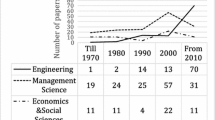Abstract
This paper focuses on the mixed binary preferences decision problem associated with the use of penalty functions in goal programming. In this sense, a new formulation approach for interval goal programming is derived, which is more efficient than the model of Jones and Tamiz. In addition, to enhance the usefulness of the proposed model, binary variables subject to the environmental constraints are added. This leads to the model of binary interval goal programming. Finally, examples to illustrate these models are given.



Similar content being viewed by others
References
Chang CT (2000). An efficient linearization approach for mixed-integer problems. Eur J Opl Res 123: 652–659.
Chang CT (2004). On the mixed binary goal programming problems. App Math Comput 159: 759–768.
Charnes A and Cooper WW (1961). Management Model and Industrial Application of Linear Programming. Vol. 1, Wiley: New York.
Charnes A and Collomb B (1972). Optimal economic stabilization policy: linear goal-interval programming models. Socio-Eco Plan Sci 6: 431–435.
Ignizio JP (1985). Introduction to Linear Goal Programming. Sage: Beverly, Hills, CA.
Jones DF and Tamiz M (1995). Expanding the flexibility of goal programming via preference modelling techniques. Omega 23: 41–48.
Lee SM (1972). Goal Programming for Decision Analysis. Auerbach: Philadelphia, PA.
Romero C (2001). Extended lexicographic goal programming: a unifying approach. Omega 29: 63–71.
Schrage (1994). LINDO Release 5.3. LINDO System, Inc.: Chicago, USA.
Tamiz M, Jones DF and Romero C (1998). Goal programming for decision making: an overview of the current state-of-the-art. Eur J Opl Res 111: 567–581.
Vitoriano B and Romero C (1999). Extended interval goal programming. J Opl Res Soc 50: 1280–1283.
Author information
Authors and Affiliations
Corresponding author
Rights and permissions
About this article
Cite this article
Chang, CT. Mixed binary interval goal programming. J Oper Res Soc 57, 469–473 (2006). https://doi.org/10.1057/palgrave.jors.2601999
Received:
Accepted:
Published:
Issue Date:
DOI: https://doi.org/10.1057/palgrave.jors.2601999




